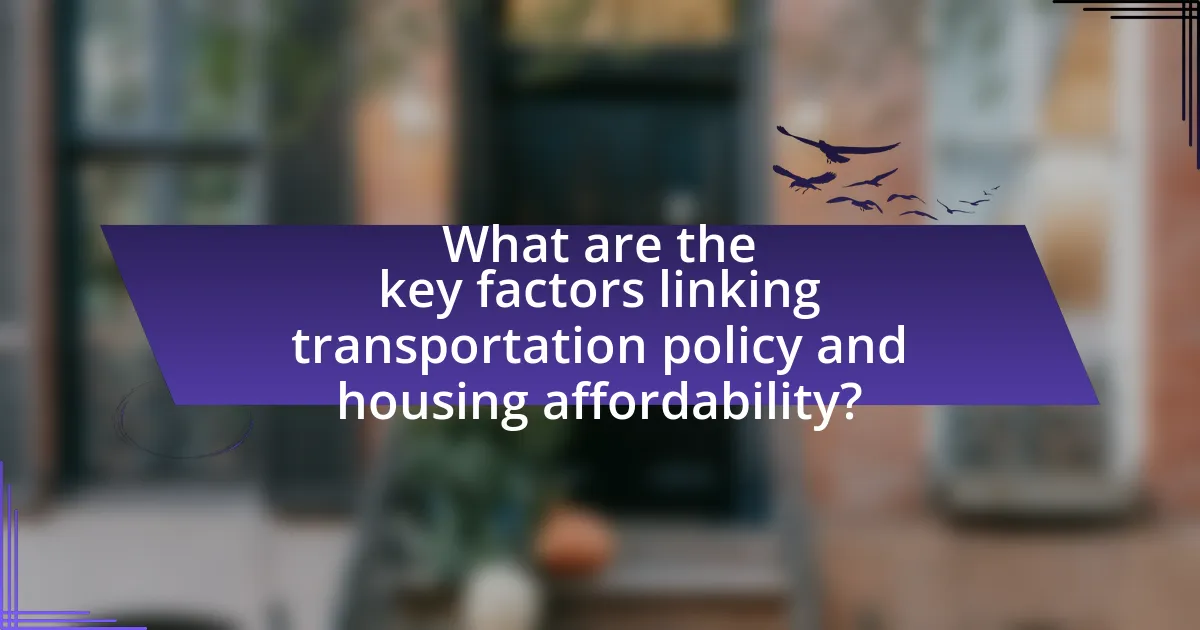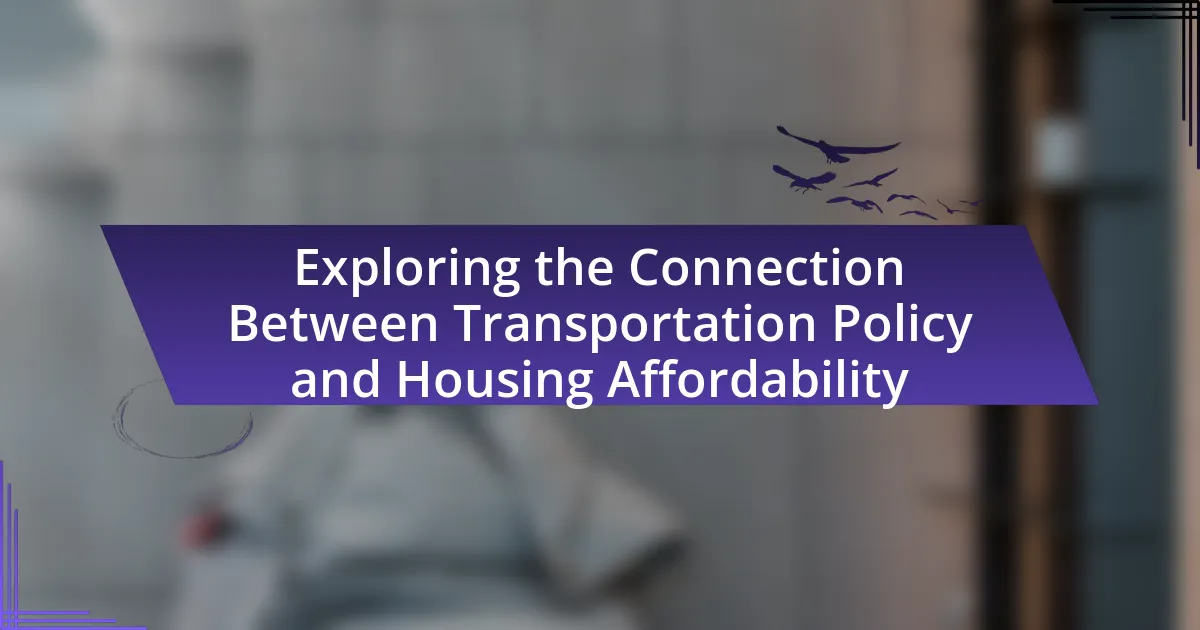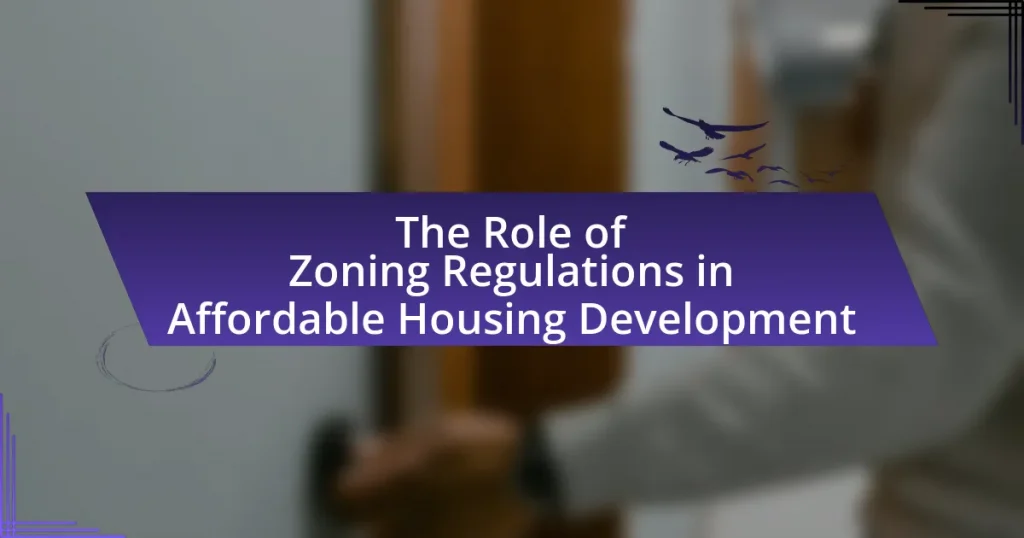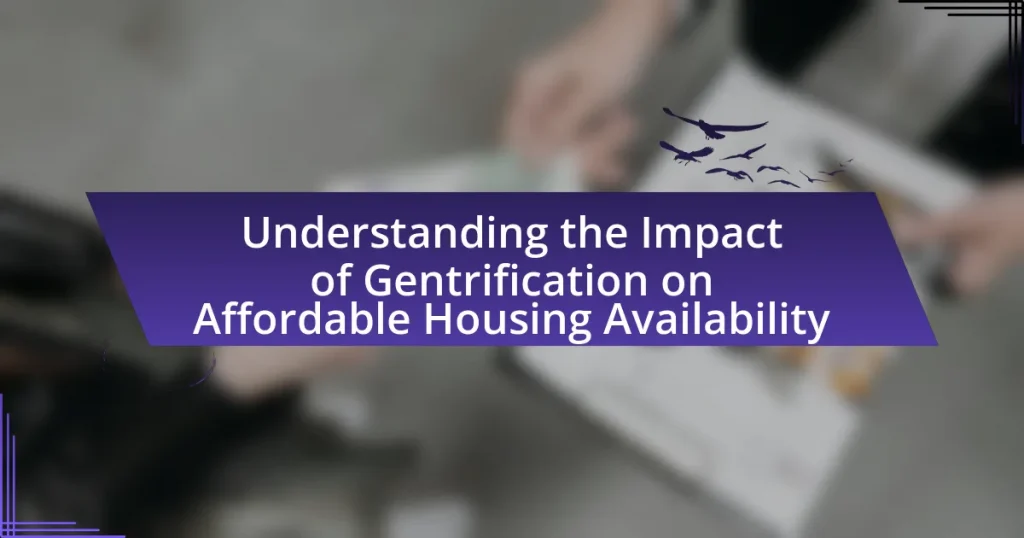The article explores the critical relationship between transportation policy and housing affordability, highlighting how transportation infrastructure and public transit access influence housing markets and prices. It examines the impact of zoning regulations, public transit investments, and commuting costs on housing choices, particularly for low-income families. The discussion includes the economic implications of transportation funding on housing development, the challenges of aligning transportation and housing policies, and successful case studies that demonstrate effective integration. Understanding this connection is essential for promoting equitable urban development and improving residents’ quality of life.

What is the connection between transportation policy and housing affordability?
Transportation policy directly influences housing affordability by determining access to public transit and infrastructure development, which affects where people can live relative to job opportunities. Areas with robust transportation options often see increased demand for housing, leading to higher prices, while regions with limited access may experience lower demand and more affordable housing options. Studies indicate that investments in public transit can enhance housing affordability by allowing residents to live farther from their workplaces without incurring excessive commuting costs, thereby expanding the housing market and reducing pressure on urban centers. For example, a report by the American Public Transportation Association found that households near public transit save an average of $9,000 annually on transportation costs, which can alleviate some financial burdens associated with housing.
How do transportation policies influence housing markets?
Transportation policies significantly influence housing markets by shaping accessibility and land use patterns. For instance, investments in public transit can increase property values in nearby areas due to improved access to jobs and amenities. A study by the American Public Transportation Association found that homes located near public transit stations can appreciate in value by 10-20% compared to those further away. Additionally, zoning regulations influenced by transportation policies can either restrict or promote housing development, impacting supply and affordability. For example, policies that encourage mixed-use developments near transit hubs can lead to a more diverse housing stock, thereby enhancing affordability options for residents.
What specific transportation policies impact housing affordability?
Transportation policies that impact housing affordability include zoning regulations, public transit investments, and road infrastructure development. Zoning regulations can restrict the density and type of housing that can be built, directly affecting supply and, consequently, prices. For instance, policies that favor single-family homes over multi-family units can limit affordable housing options. Public transit investments enhance accessibility to urban areas, often leading to increased housing demand in those regions, which can drive up prices. A study by the Urban Institute found that areas with robust public transit options see a 20% increase in housing prices compared to those without. Additionally, road infrastructure development can influence where people choose to live, as improved access to highways may lead to suburban sprawl, affecting housing costs in both urban and suburban areas.
How do transportation costs affect housing choices for families?
Transportation costs significantly influence housing choices for families by affecting their overall budget and location preferences. Families often seek housing in areas where transportation expenses are lower, which can lead them to choose homes farther from urban centers where public transit options are limited or car dependency is high. According to a study by the Center for Neighborhood Technology, transportation costs can account for up to 20% of a household’s budget, prompting families to prioritize affordable housing in locations with better access to public transportation. This shift can result in families opting for suburban or rural areas, where housing may be cheaper, but commuting costs can offset those savings. Thus, the interplay between transportation costs and housing choices is critical in determining where families decide to live.
Why is understanding this connection important?
Understanding the connection between transportation policy and housing affordability is crucial because it directly influences urban development and residents’ quality of life. Effective transportation policies can enhance access to affordable housing, reduce commuting costs, and promote economic opportunities, thereby improving overall community well-being. For instance, research from the Urban Institute indicates that areas with robust public transit options tend to have lower housing costs relative to income, demonstrating that transportation accessibility can mitigate housing affordability challenges.
What are the social implications of transportation and housing affordability?
Transportation and housing affordability significantly impact social equity and community cohesion. When transportation costs are high relative to housing expenses, low-income families often face financial strain, leading to increased stress and reduced access to essential services such as healthcare and education. According to a report by the Center for Neighborhood Technology, households that spend more than 45% of their income on housing and transportation are considered “cost-burdened,” which can exacerbate social inequalities. Furthermore, inadequate transportation options can limit job opportunities for residents in affordable housing areas, perpetuating cycles of poverty and limiting upward mobility. This interdependence highlights the need for integrated policies that address both transportation and housing to foster more equitable communities.
How does this connection affect urban planning and development?
The connection between transportation policy and housing affordability significantly influences urban planning and development by shaping land use patterns and accessibility. Effective transportation policies can enhance housing affordability by promoting mixed-use developments and reducing reliance on personal vehicles, which lowers transportation costs for residents. For instance, cities that invest in public transit systems often see increased property values near transit hubs, as evidenced by a study from the American Public Transportation Association, which found that properties near public transit can appreciate by 20% or more. This appreciation encourages urban planners to prioritize transit-oriented development, ultimately leading to more sustainable and affordable housing options.

What are the key factors linking transportation policy and housing affordability?
Transportation policy significantly influences housing affordability through factors such as accessibility, infrastructure investment, and land use regulations. Accessibility affects housing costs by determining how easily residents can reach employment centers, with areas well-served by public transit often experiencing higher demand and, consequently, higher prices. Infrastructure investment, including the development of roads and transit systems, can enhance property values in surrounding neighborhoods, impacting affordability. Additionally, land use regulations, which dictate zoning and development patterns, can restrict housing supply in areas with robust transportation options, further driving up costs. Studies have shown that regions with integrated transportation and housing policies tend to have more affordable housing options, highlighting the importance of coordinated planning efforts.
How does accessibility influence housing prices?
Accessibility significantly influences housing prices by increasing demand for properties located near transportation hubs and essential services. Areas with better accessibility often see higher property values because they offer convenience, reduced commuting times, and improved quality of life. For instance, a study by the National Association of Realtors found that homes within a half-mile of public transit stations can command prices that are 20% higher than similar homes located further away. This correlation between accessibility and housing prices underscores the importance of transportation policy in shaping housing affordability.
What role does public transit play in determining housing costs?
Public transit significantly influences housing costs by enhancing accessibility to urban areas, which increases demand for nearby housing. Areas with robust public transit systems often experience higher property values due to the convenience they offer residents, leading to increased competition for housing. For instance, a study by the American Public Transportation Association found that homes located near public transit can command prices up to 30% higher than those further away. This correlation indicates that effective public transit not only shapes housing demand but also directly impacts affordability in urban settings.
How do commuting times affect residential location choices?
Commuting times significantly influence residential location choices, as individuals often prioritize shorter travel durations to work or essential services. Research indicates that longer commuting times can lead to a preference for housing located closer to employment centers, thereby increasing demand in those areas. For instance, a study by the Urban Land Institute found that a 10-minute increase in commute time can reduce the likelihood of choosing a particular neighborhood by 20%. This demonstrates that as commuting times rise, potential residents may opt for locations that offer better access to public transportation or major roadways, ultimately shaping housing market dynamics and affecting housing affordability.
What are the economic impacts of transportation policy on housing?
Transportation policy significantly influences housing markets by affecting accessibility, land values, and development patterns. Improved transportation infrastructure, such as public transit systems, typically increases the desirability of nearby housing, leading to higher property values and rents. For instance, studies have shown that properties located near transit stations can see value increases of 10% to 20% compared to those further away. Conversely, transportation policies that prioritize automobile use can lead to urban sprawl, increasing housing costs in outlying areas while reducing affordability in urban centers. Additionally, transportation investments can stimulate economic development, creating jobs and attracting businesses, which further impacts housing demand and prices.
How do transportation investments affect property values?
Transportation investments generally increase property values by enhancing accessibility and connectivity. Improved transportation infrastructure, such as roads, public transit, and bike lanes, makes areas more desirable for residents and businesses. For instance, a study by the National Association of Realtors found that homes located near public transit stations can sell for 20% more than similar homes farther away. Additionally, the presence of efficient transportation options often leads to reduced commuting times, which further elevates the attractiveness of neighborhoods. This correlation between transportation investments and property values is supported by various urban economic studies, demonstrating that enhanced mobility can lead to increased demand for housing in well-connected areas.
What is the relationship between transportation funding and housing development?
Transportation funding directly influences housing development by enhancing accessibility and infrastructure, which in turn attracts residential projects. When transportation funding is allocated to improve roads, public transit, and other infrastructure, it increases the desirability of areas for housing development. For instance, studies have shown that regions with robust transportation networks experience higher rates of housing construction and increased property values. A report by the Urban Land Institute indicates that areas with improved transit access see a 20% increase in housing demand, demonstrating the clear link between transportation investment and housing growth.

What are the challenges in aligning transportation policy with housing affordability?
Aligning transportation policy with housing affordability faces significant challenges, primarily due to conflicting priorities and resource allocation. Transportation policies often prioritize infrastructure development and expansion, which can lead to increased costs for housing in areas with improved access. For instance, when new transit lines are established, property values in those areas typically rise, making housing less affordable for low-income residents. Additionally, funding for transportation projects can divert resources away from affordable housing initiatives, exacerbating the housing crisis. According to a report by the Urban Institute, cities that invest heavily in transportation infrastructure without concurrent affordable housing strategies often see a widening gap in housing affordability, highlighting the need for integrated planning approaches.
What barriers exist in implementing effective transportation policies?
Barriers in implementing effective transportation policies include funding limitations, political resistance, and public opposition. Funding limitations arise from budget constraints at local, state, and federal levels, which restrict the ability to invest in necessary infrastructure and services. Political resistance often stems from differing priorities among stakeholders, including government officials and community leaders, who may prioritize other issues over transportation. Public opposition can occur when proposed policies do not align with community needs or when residents fear negative impacts, such as increased congestion or displacement. These barriers hinder the development and execution of comprehensive transportation strategies that could enhance housing affordability and accessibility.
How do political and economic factors hinder policy alignment?
Political and economic factors hinder policy alignment by creating conflicting interests among stakeholders. For instance, political agendas may prioritize short-term electoral gains over long-term policy coherence, leading to fragmented transportation and housing policies. Economically, disparities in funding and resource allocation can result in unequal investment in infrastructure, which exacerbates housing affordability issues. Research indicates that regions with strong political will and economic resources tend to achieve better policy alignment, while those lacking these factors struggle to coordinate effectively, as seen in various urban planning studies.
What are the consequences of inadequate transportation planning on housing?
Inadequate transportation planning leads to increased housing costs and reduced accessibility. When transportation infrastructure is poorly designed or insufficient, it can result in longer commutes, which raises the cost of living in areas with limited transit options. For instance, a study by the Urban Land Institute found that households in well-connected areas spend significantly less on transportation, allowing them to allocate more resources to housing. Additionally, inadequate transportation can limit housing development in desirable locations, exacerbating housing shortages and driving up prices. This creates a cycle where low-income families are pushed further from job centers, increasing their transportation costs and reducing their overall affordability.
How can stakeholders address these challenges?
Stakeholders can address the challenges of transportation policy and housing affordability by implementing integrated planning strategies that align transportation infrastructure with housing development. This approach ensures that new housing projects are located near public transit options, reducing reliance on personal vehicles and lowering transportation costs for residents. For instance, cities like Portland have successfully utilized transit-oriented development to enhance accessibility and affordability, demonstrating that coordinated efforts can lead to improved housing outcomes. Additionally, stakeholders can advocate for policies that promote mixed-use developments, which combine residential, commercial, and transportation facilities, thereby fostering vibrant communities and reducing overall living expenses.
What strategies can be employed to improve transportation and housing policy integration?
To improve transportation and housing policy integration, strategies such as coordinated planning, mixed-use development, and equitable transit access should be employed. Coordinated planning involves aligning transportation and housing policies at the local and regional levels to ensure that housing developments are situated near public transit options, thereby reducing reliance on cars and promoting sustainable living. Mixed-use development encourages the creation of neighborhoods that combine residential, commercial, and recreational spaces, which can enhance accessibility and reduce travel distances. Equitable transit access ensures that all communities, particularly low-income and marginalized groups, have reliable access to public transportation, which is essential for accessing jobs and services. These strategies are supported by research indicating that integrated policies can lead to improved housing affordability and reduced transportation costs, ultimately fostering more sustainable urban environments.
How can community engagement enhance policy effectiveness?
Community engagement enhances policy effectiveness by ensuring that policies are informed by the needs and perspectives of the community they affect. Engaging community members allows policymakers to gather valuable insights, identify local priorities, and foster trust, which can lead to greater public support and compliance. For instance, studies show that transportation policies developed with community input are more likely to address specific local issues, resulting in improved outcomes such as increased public transit usage and better alignment with housing affordability goals. This collaborative approach not only improves the relevance of policies but also encourages community ownership, leading to sustained engagement and long-term success.
What best practices can be adopted for better outcomes?
Adopting integrated transportation and housing policies leads to better outcomes in urban planning. This approach ensures that housing developments are located near public transit options, reducing commuting times and costs for residents. For instance, studies show that areas with accessible public transportation see a 20% increase in housing affordability, as residents can save on transportation expenses. Additionally, implementing mixed-use developments encourages walkability and reduces reliance on cars, further enhancing affordability and quality of life. Evidence from cities like Portland and San Francisco demonstrates that coordinated planning between transportation and housing sectors results in sustainable urban growth and improved economic opportunities for residents.
What successful case studies exist in transportation and housing policy integration?
Successful case studies in transportation and housing policy integration include the San Francisco Bay Area’s Plan Bay Area and Portland’s 2040 Growth Concept. Plan Bay Area, implemented by the Metropolitan Transportation Commission and the Association of Bay Area Governments, aligns land use and transportation planning to promote sustainable development, resulting in increased housing near transit hubs and reduced vehicle miles traveled. Portland’s 2040 Growth Concept emphasizes compact urban development and transit-oriented design, leading to a significant increase in affordable housing options and improved public transit accessibility. Both cases demonstrate effective integration of transportation and housing policies, contributing to enhanced affordability and sustainability in urban environments.
How can data-driven approaches improve policy decisions?
Data-driven approaches can improve policy decisions by providing empirical evidence that informs and guides the decision-making process. These approaches utilize quantitative data analysis, which allows policymakers to identify trends, assess the impact of existing policies, and forecast the outcomes of proposed initiatives. For instance, a study by the Urban Institute found that data-driven transportation policies can lead to more efficient resource allocation, ultimately enhancing housing affordability by optimizing transit routes and reducing travel times for low-income residents. This evidence-based methodology ensures that policies are not only reactive but also proactive, addressing issues before they escalate.



